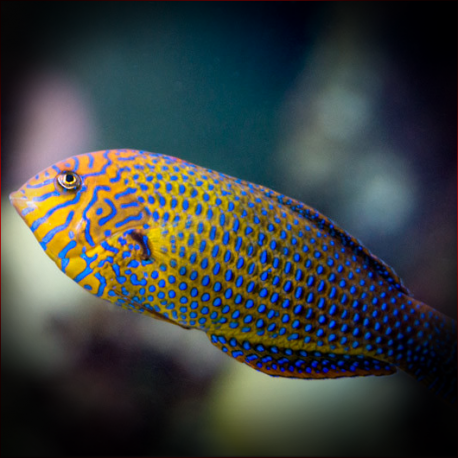More info
Datasheet
| Minimum Tank Size | 500 litres / 132.09 US gallons |
| Maximum Size | 15.0cm / 5.91inches |
| Reef Compatible | Always reef safe |
| Temperament | Docile |
| Temperature | 22.2°C / 71.96°F - 25.6°C / 78.08°F |
| Specific Gravity | 1.020-1.025 |
| Carbonate Hardness | 8-12 |
| pH | 8.1-8.4 |
General Description
The Potter's Wrasse, also known as the Shortnose wrasse or Geoffroy's wrasse, belonging to the Labridae family specifically Macropharyngodon genus, showcases captivating colors and patterns. These fish, with a maximum size of 15.0cm, inhabit the Pacific Ocean from Hawaii southward to central Polynesia, extending westward through Micronesia and the East Indies. Wrasses, in general, are prevalent in reef aquariums for their attractiveness and usefulness in controlling unwanted invertebrates like flatworms and pyramid snails. They feed on various marine organisms, ranging from zooplankton to large crustaceans and sea urchins.
Aquarium Suitability
Aquarium enthusiasts must exercise caution when considering the Potter's Wrasse due to its demanding dietary needs. These fish require a well-established tank where they can forage for small snails and pods. Keeping them in an aquarium without ample food sources can lead to malnutrition and eventual death. Therefore, it is recommended not to house them with competing species for the same food resources. Additionally, supplementing their diet with frozen foods multiple times a day is crucial for their health and well-being.
Care and Hardiness
The Potter's Wrasse is classified as having average hardiness and docile temperament. They exhibit shy behavior and should not be housed with aggressive tank mates. These wrasses have a unique survival strategy of burrowing into the sand when threatened or needing rest. To prevent injuries, it is essential to provide a deep sandy substrate of at least 5 cm in the aquarium.
Reef Suitability
The Potter's Wrasse is considered reef-safe, making them suitable for reef aquarium setups. However, they require a minimum tank size of 500 liters and prefer a peaceful environment free from aggressive fish that may hinder their feeding habits.
Aquarium Setup
Creating an ideal aquarium setup for Potter's Wrasse involves providing a deep sandy substrate for burrowing, plenty of live rock for exploration and hiding spots, and a consistent supply of small snails and pods for their natural feeding behaviors. Maintaining water conditions within the parameters of pH 8.1-8.4, dKH 8-12, salinity of 1.020-1.025, and a temperature range of 22.2-25.6°C is essential for their well-being.
Behaviour
Potter's Wrasses are known to be sensitive during transportation and acclimatization, necessitating extra care during these processes. When feeling threatened, they exhibit a unique behavior of burying themselves in the sand for safety.
Feeding and Diet
Their recommended diet includes small crustaceans like krill, mysis, and artemia, as well as zooplankton such as Cyclops and pods. These wrasses require frequent feeding several times a day, especially when first introduced into the aquarium.
Dimorphism and Captive Reproduction
Potter's Wrasses are hermaphroditic, capable of changing gender from female to male as needed. In a captive setting, their reproductive behavior can be observed if provided with the appropriate conditions and care.
Habitat and Distribution
Found in the Pacific Ocean, Potter's Wrasses inhabit regions from Hawaii to central Polynesia, westward through Micronesia, and into the East Indies. Their natural habitat consists of coral reefs and sandy substrates, where they can exhibit their natural behaviors and foraging activities.

